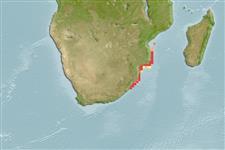Elasmobranchi (squali e razze) (sharks and rays) >
Rajiformes (Skates and rays) >
Rajidae (Skates)
Etymology: Dipturus: Greek, di = two + Greek, pteryx = fin (Ref. 45335).
Eponymy: Dr George Gordon Campbell (1893–1977) was a South African physician and naturalist who inspired the Foundation for Marine Biological Research and was President of it, for which he was honoured in the name of the skate. [...] (Ref. 128868), visit book page.
Environment: milieu / climate zone / distribuzione batimetrica / distribution range
Ecologia
marino demersale; distribuzione batimetrica 137 - 403 m (Ref. 5578). Subtropical; 20°S - 31°S, 30°E - 38°E (Ref. 114953)
Western Indian Ocean: off central Mozambique to Durban, South Africa.
Size / Peso / Age
Maturità: Lm ? range ? - ? cm
Max length : 66.0 cm TL maschio/sesso non determinato; (Ref. 5578)
Short description
Chiavi di identificazione | Morfologia | Morfometria
A black-spotted longnose skate with an elongated, acutely triangular snout, and a stout tail- just shorter than body and slightly swollen along the mid-section; disc with rounded corners and smooth underside except for small denticles on edges and tip of snout; small thorns on nape and midback to 1st dorsal fin (Ref. 5578). Medium grey to brownish with numerous small dark spots dorsally; grey with conspicuous black pores ventrally (Ref. 5578).
Body shape (shape guide): other.
Found on the bottom of the outer shelf and upper slope (Ref. 5578). Probably caught by trawlers (Ref. 5578).Oviparous (Ref. 50449). Eggs have horn-like projections on the shell (Ref. 205). Males reaches maturity at ca. 57 cm TL, females at ca. 64 cm TL (Ref. 114953)
Life cycle and mating behavior
Maturità | Riproduzione | Deposizione | Uova | Fecundity | Larve
Oviparous, paired eggs are laid. Embryos feed solely on yolk (Ref. 50449). Eggs have horn-like projections on the shell (Ref. 205).
McEachran, J.D. and K.A. Dunn, 1998. Phylogenetic analysis of skates, a morphologically conservative clade of elasmobranchs (Chondrichthyes: Rajidae). Copeia 1998(2):271-290. (Ref. 27314)
IUCN Red List Status (Ref. 130435: Version 2025-1)
Threat to humans
Harmless
Human uses
Strumenti
Special reports
Download XML
Fonti Internet
Estimates based on models
Preferred temperature (Fonte Biblio.
123201): 8.8 - 21.2, mean 14.4 °C (based on 4 cells).
Phylogenetic diversity index (Fonte Biblio.
82804): PD
50 = 0.5000 [Uniqueness, from 0.5 = low to 2.0 = high].
Bayesian length-weight: a=0.00282 (0.00131 - 0.00604), b=3.25 (3.08 - 3.42), in cm total length, based on LWR estimates for this Genus-body shape (Ref.
93245).
Trophic level (Fonte Biblio.
69278): 3.8 ±0.6 se; based on size and trophs of closest relatives
Resilienza (Fonte Biblio.
120179): Basso, tempo minimo di raddoppiamento della popolazione 4.5 - 14 anni (Fec assumed to be <100).
Fishing Vulnerability (Ref.
59153): Moderate to high vulnerability (46 of 100).
🛈
